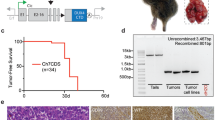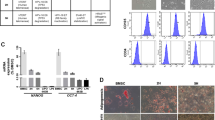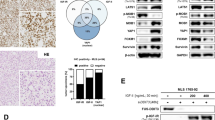Abstract
Fusion proteins created by chromosomal abnormalities are key components of mesenchymal cancer development. The most common chromosomal translocation in liposarcomas, t(12;16)(q13;p11), creates the FUS–CHOP fusion gene. In the past, we generated FUS–CHOP and CHOP transgenic mice and have shown that while FUS–CHOP transgenic develop liposarcomas, mice expressing CHOP, which lacks the FUS domain, display essentially normal white adipose tissue (WAT) development, suggesting that the FUS domain of FUS–CHOP plays a specific and critical role in the pathogenesis of liposarcoma. To test the significance of FUS and CHOP domain interactions within a living mouse, we generated mice expressing the FUS domain and crossed them with CHOP-transgenic mice to generate double-transgenic FUSxCHOP animals. Here we report that expression of the FUS domain restores liposarcoma development in CHOP-transgenic mice. Our results provide genetic evidence that FUS and CHOP domains function in trans for the mutual restoration of liposarcoma. These results identify a new mechanism of tumor-associated fusion genes and might have impact beyond myxoid liposarcoma.
This is a preview of subscription content, access via your institution
Access options
Subscribe to this journal
Receive 50 print issues and online access
$259.00 per year
only $5.18 per issue
Buy this article
- Purchase on Springer Link
- Instant access to full article PDF
Prices may be subject to local taxes which are calculated during checkout





Similar content being viewed by others
References
Aman P, Panagopoulos I, Lassen C, Fioretos T, Mencinger M, Toresson H, Hoglund M, Forster A, Rabbitts TH, Ron D, Mandahl N, Mitelman F . 1996 Genomics 37: 1–8
Batchvarova N, Wang XZ, Ron D . 1995 EMBO J. 14: 4654–4661
Carlson SG, Fawcett TW, Bartlett JD, Bernier M, Holbrook NJ . 1993 Mol. Cell. Biol. 13: 4736–4744
Castellanos A, Pintado B, Wuruaga E, Arévalo R, López A, Orfao A, Sánchez-García I . 1997 Blood 90: 2168–2174
Chang HR, Hajdu SI, Collin C, Brennan MP . 1989 Cancer 64: 1514–1520
Crozat A, Aman P, Mandahl N, Ron D . 1993 Nature 363: 640–644
Fornace Jr AJ, Nebert DW, Hollander MC-, Luethy JD, Papathanasiou M, Fargnoli J, Holbrook N-J . 1989 Mol. Cell. Biol. 9: 4196–4203
Ichikawa H, Shimizu K, Hayashi Y, Ohki M . 1994 Cancer Res. 54: 2865–2868
Knight JC, Renwick PJ, Cin PD, Van den Berghe H, Fletcher CD . 1995 Cancer Res. 55: 24–27
Mack TM . 1995 Cancer 75: 211–244
Mizushima S, Nagata S . 1990 Nucleic Acids Res. 18: 4322–
Panagopoulos I, Aman P, Fioretos T, Höghind M, Johansson B, Mandahl N, Heim S, Behrendtz M, Mitelman F . 1994 Genes Chrom. Cancer 11: 256–262
Panagopoulos I, Mandahl N, Mitelman F, Aman P . 1995 Oncogene 11: 1133–1137
Pérez-Losada J, Pintado B, Gutiérrez-Adán A, Flores T, Bañares-González B, Calabia del Campo J, Martín-Martín JF, Battaner E, Sánchez-García I . 2000a Oncogene 19: 2413–2422
Pérez-Losada J, Sánchez-Martín M, Rodríguez-García MA, Pérez-Mancera PA, Pintado B, Flores T, Battaner E, Sánchez-García I . 2000b Oncogene 19: 6015–6022
Prasad DD, Ouchida M, Lee L, Rao VN, Peddy ESP . 1994 Oncogene 9: 3717–3729
Price BD, Calderwood SK . 1992 Cancer Res. 52: 3814–3817
Rabbitts TH, Forster A, Larson R, Nathan P . 1993 Nature Genet. 4: 175–180
Ron D, Habener JF . 1992 Genes Dev. 6: 439–453
Sánchez-García I, Rabbitts TH . 1994 Proc. Natl. Acad. Sci. USA 91: 7869–7873
Sánchez-García I . 1997 Annu. Rev. Genetics 31: 429–453
Shimizu K, Ichikawa H, Tojo A, Kaneko Y, Maseki N et al. 1993 Proc. Natl. Acad. Sci. USA 90: 10280–10284
Tontonoz P, Singer S, Forman BM, Sarraf P, Fletcher JA, Fletcher CDM, Brun RP, Mueller E, Altiok S, oppenheim H, Evans RM, Spiegelman BM . 1997 Proc. Natl. Acad. Sci. USA 94: 237–241
Wang XZ, Lawson B, Brewer JW, Zinszner H, Sanjay A, Mi LJ, Boorstein R, Kreibich G, Hendershot LM, Ron D . 1996 Mol. Cell. Biol. 16: 4273–4280
Zinszner H, Albalat R, Ron D . 1994 Genes Dev. 8: 2513–2526
Acknowledgements
We are grateful to JC Villoria-Terrón for excellent technical assistance with mice. We are indebted to members of lab 13 for helpful discussions, and specific thanks to Prof R González-Sarmiento for his unconditional help and support. This work has been supported by DGCYT (1FD97-0360, SAF2000-0148, BIO2000-0453-P4-02 and 1FD97-1126), Fundación Científica of the AECC, Junta de Castilla y León (C.S.12/99 and C.S.I. 3/01), FIS (99/0935 and 01/0114), and NIH grant (1 R01 CA79955-01). PA Pérez-Mancera and MA Rodríguez-García are scholarship holders from MEC and CSIC-GLAXO, respectively.
Author information
Authors and Affiliations
Corresponding author
Rights and permissions
About this article
Cite this article
Pérez-Mancera, P., Pérez-Losada, J., Sánchez-Martín, M. et al. Expression of the FUS domain restores liposarcoma development in CHOP transgenic mice. Oncogene 21, 1679–1684 (2002). https://doi.org/10.1038/sj.onc.1205220
Received:
Revised:
Accepted:
Published:
Issue Date:
DOI: https://doi.org/10.1038/sj.onc.1205220
Keywords
This article is cited by
-
Modeling sarcomagenesis using multipotent mesenchymal stem cells
Cell Research (2012)
-
Mechanisms of sarcoma development
Nature Reviews Cancer (2003)



